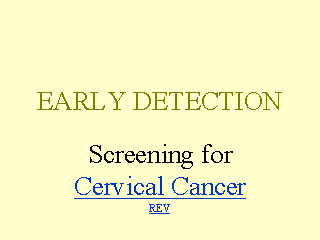Search inside of Supercourse and lectures in HTML and PPT format
 |
|

|
front |1 |2 |3 |4 |5 |6 |7 |8 |9 |10 |11 |12 |13 |14 |15 |16 |17 |18 |19 |20 |21 |22 |23 |24 |25 |26 |27 |28 |29 |30 |31 |review |
 Implementation for cytology screening for cervical cancer requires several steps: A program of health education is needed to raise awareness of the disease and the importance of early diagnosis by screening for curability. A policy is needed to restrict examination to women over 35 years of age (see below). This may have to be modified if significant numbers of cases of cervical cancer are seen in a country in younger women. Then a practical and effective mechanism to identify women in the target age group of 35 to 59 years of age must be devised. Female primary health workers are then trained to examine the cervix and take PAP smears, and instructed on proper case finding and referral procedures. Cytotechnicians and cytopathologists also need to be trained. Proper cytology laboratories must be established, strategically located geographically, and of such a size that they will handle sufficient smears annually to maintain competence. Quality control is needed. A link is needed between identification of an abnormality and referral to be sure that all suspected lesions are properly diagnosed and treated, and that women receive proper follow-up. An information system will also be needed to allow for monitoring and evaluation of the program, including measurement of the downstaging phenomenon. |